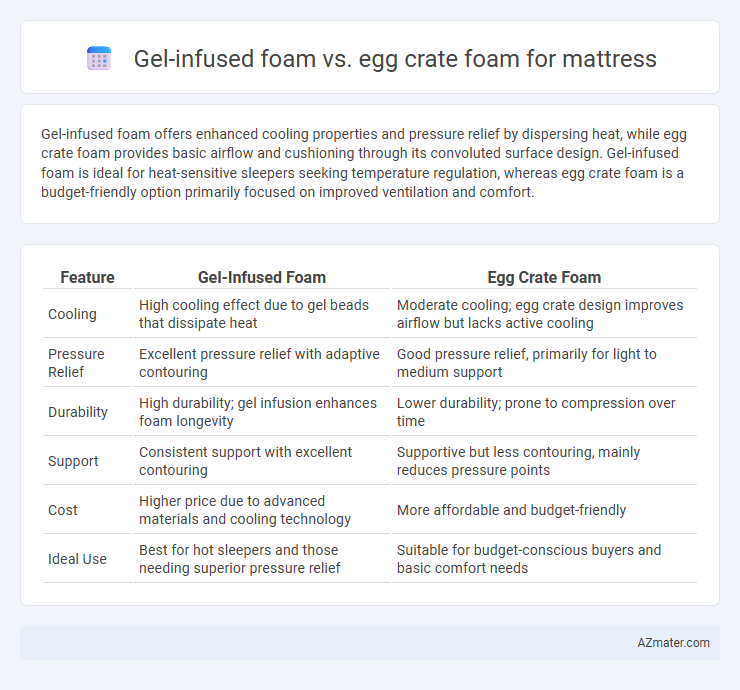Gel-infused foam offers enhanced cooling properties and pressure relief by dispersing heat, while egg crate foam provides basic airflow and cushioning through its convoluted surface design. Gel-infused foam is ideal for heat-sensitive sleepers seeking temperature regulation, whereas egg crate foam is a budget-friendly option primarily focused on improved ventilation and comfort.
Table of Comparison
| Feature | Gel-Infused Foam | Egg Crate Foam |
|---|---|---|
| Cooling | High cooling effect due to gel beads that dissipate heat | Moderate cooling; egg crate design improves airflow but lacks active cooling |
| Pressure Relief | Excellent pressure relief with adaptive contouring | Good pressure relief, primarily for light to medium support |
| Durability | High durability; gel infusion enhances foam longevity | Lower durability; prone to compression over time |
| Support | Consistent support with excellent contouring | Supportive but less contouring, mainly reduces pressure points |
| Cost | Higher price due to advanced materials and cooling technology | More affordable and budget-friendly |
| Ideal Use | Best for hot sleepers and those needing superior pressure relief | Suitable for budget-conscious buyers and basic comfort needs |
Introduction to Gel-Infused Foam and Egg Crate Foam
Gel-infused foam integrates cooling gel beads within viscoelastic foam, enhancing temperature regulation and pressure relief compared to traditional foams. Egg crate foam features a convoluted surface designed to increase airflow and reduce pressure points, often used for lightweight cushioning and medical purposes. Choosing between gel-infused foam and egg crate foam depends on desired comfort level, cooling needs, and specific support requirements for mattresses.
What is Gel-Infused Foam?
Gel-infused foam is a type of memory foam embedded with cooling gel beads designed to dissipate heat and enhance airflow, providing a cooler sleeping surface compared to traditional foam. This material adapts to body contours while regulating temperature, making it ideal for hot sleepers or those seeking pressure relief combined with temperature control. In contrast, egg crate foam offers basic cushioning and ventilation with its egg crate-shaped design but lacks the advanced cooling properties and adaptive comfort provided by gel-infused foam.
Understanding Egg Crate Foam Technology
Egg crate foam features a distinctive convoluted pattern designed to enhance airflow and pressure relief by distributing body weight evenly across its peaks and valleys. This technology improves mattress ventilation and reduces heat retention compared to traditional foam, promoting a cooler and more comfortable sleep experience. While gel-infused foam incorporates cooling gel beads to actively dissipate heat, egg crate foam relies on its unique surface structure to naturally increase breathability and reduce localized pressure points.
Breathability and Temperature Regulation Comparison
Gel-infused foam enhances breathability and temperature regulation by incorporating cooling gel beads that dissipate heat and promote airflow, reducing heat retention during sleep. Egg crate foam, designed with a convoluted surface, increases airflow through its peaks and valleys but lacks the advanced cooling properties of gel infusion. For optimal temperature control and breathability, gel-infused foam offers superior performance compared to traditional egg crate foam.
Pressure Relief and Comfort Analysis
Gel-infused foam offers superior pressure relief by dispersing body heat and conforming to curves, reducing pressure points and enhancing comfort for side and back sleepers. Egg crate foam provides moderate pressure distribution through its convoluted surface, improving airflow but often lacking the contouring support of gel-infused options. For optimal comfort and pressure alleviation, gel-infused foam typically outperforms egg crate foam in maintaining spinal alignment and reducing discomfort during extended rest.
Durability and Longevity: Which Lasts Longer?
Gel-infused foam offers enhanced durability due to its advanced cooling technology and higher density, which helps maintain structural integrity over time compared to egg crate foam. Egg crate foam, typically made from lower-density polyurethane, tends to compress and degrade faster, reducing its lifespan and support quality. Overall, gel-infused foam mattresses are designed to last longer, providing extended comfort and resilience for years of use.
Motion Isolation: Which Foam Minimizes Disturbance?
Gel-infused foam excels in motion isolation by absorbing and dispersing movement effectively, reducing partner disturbances during sleep. Egg crate foam, while providing some cushioning, generally lacks the density and elasticity needed to fully minimize motion transfer. Mattresses with gel-infused foam layers offer superior motion isolation compared to egg crate foam, enhancing uninterrupted rest.
Allergy and Health Considerations
Gel-infused foam mattresses offer enhanced breathability and antimicrobial properties that help reduce dust mites and allergens, making them a better choice for allergy sufferers. Egg crate foam, while providing basic airflow and pressure relief, lacks advanced antimicrobial treatments and may harbor more dust mites over time. Choosing gel-infused foam can contribute to improved air quality and healthier sleep environments for individuals prone to allergies or respiratory issues.
Cost and Value Differences
Gel-infused foam mattresses typically cost more than egg crate foam due to advanced cooling technology and improved pressure relief benefits. Egg crate foam offers a budget-friendly option with basic cushioning but lacks the durability and temperature regulation found in gel-infused variants. The higher initial investment in gel-infused foam often translates to better long-term value through enhanced comfort and extended mattress lifespan.
Choosing the Right Foam: Gel-Infused vs Egg Crate for Your Mattress
Gel-infused foam outperforms egg crate foam by providing superior cooling properties due to embedded gel beads that regulate temperature and reduce heat retention. Egg crate foam, with its convoluted surface, enhances airflow and pressure relief but may lack the advanced thermal regulation found in gel-infused variants. Choosing the right foam depends on whether temperature control (gel-infused foam) or improved ventilation and budget-friendliness (egg crate foam) is the primary criterion for mattress comfort.

Infographic: Gel-infused foam vs Egg crate foam for Mattress
 azmater.com
azmater.com